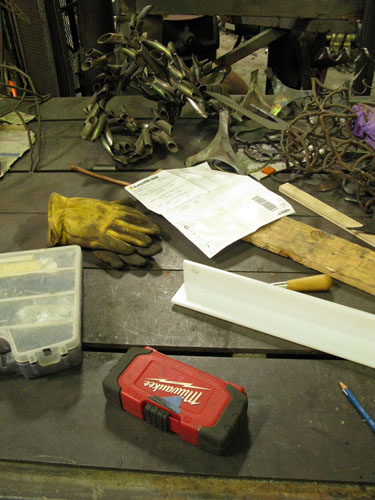Portrait of a mad scientist: Alan Rorie of Almostscientific.com
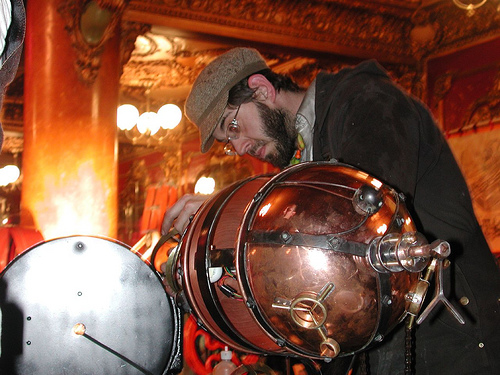
(image: Alan Rorie working on the Dihemispheric Chronaether Agitator. Photo by Flickr user and KSW patron Great!steam)
I've never been so enamored with any character type as I have with the mad scientist. The shop, filled with inventions, doo-dads; explosions from nowhere send machinery flying while (s)he runs yelling equations to no-one. The wide-eyed ecstatic expression of pure insanity; the giant eyebrows. The filthy white lab coat. The giant gloves.
With the exception of the gloves (and possibly the eyebrows), Alan Rorie is that taken from the best of these characters and put into rusty reality. A doctorate student at Stanford, he goes from the precision and white sterile walls of the laboratory to his grimy, rusty, enchantingly-cluttered shop at the west Oakland group art space NIMBY.
I met him first working on the Steampunk Treehouse , and have been since always impressed with his work; firstly the Dihemispheric Chronaether Agitator; and then the Neuron chamber. His exploits, scientific, artistic, and otherwise- can be followed on his site Almostscientific.com
He recently was so patient and kind to put down the high-voltage regulators and tell me a bit about himself. Lots of photos and the interview behind the cut.
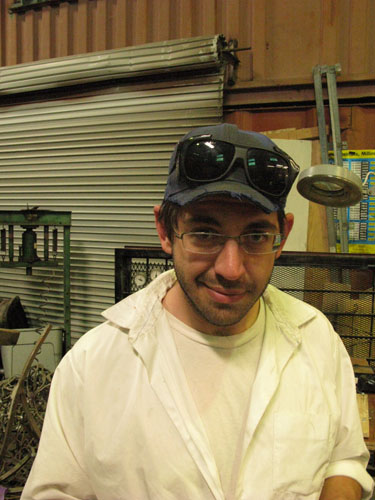
So, mad scientist/creator/artist, eh?
That's what they say around the playground.
But, yeah, scientist, artist I'd say I'm a bit of both at various times; sometimes more of one then the other — usually not that one that is most appropriate or helpful to the situation.
It's funny because in my lab (where I'm working on my graduate thesis) I'm the crazy artist guy, with the bad haircut, who hangs in gigantic, industrial-arts warehouses with all the strange, tattooed people; and goes to parties where shopping carts are crushed between giant steam-engine driven gears. But when I'm at those parties watching my friends crush a shopping cart between giant stem-engine driven gears (something I don't advise you kids at home to do — by the by) I'm known as the geeked-out, precision-oriented, Stanford scientist with the bad haircut, who spends his days doing experiments and writing computer code to process data.
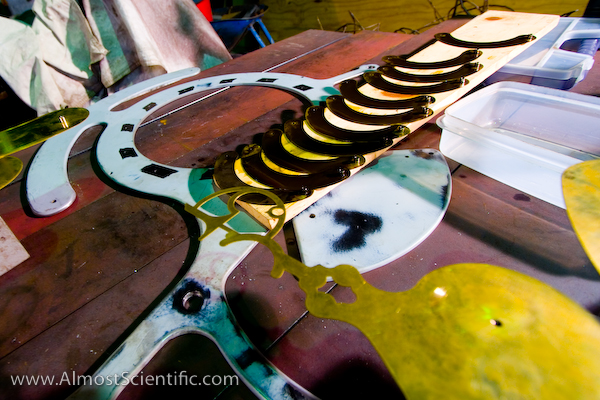
What interests you in the art and science worlds, and how do they connect for you? (image: blades of the Triaparator)
Well my core interest in science is Neurobiology, the field I'm completing my Ph.D. thesis in down at Stanford. So, yeah, obviously I'm interested in my thesis work on how sensory and reward information are dynamically combined in the brain (blah blah blah). But beyond that I think there is allot going on in science that is mind-blowing.
I'm really fascinated right now by Astrobiology, which is the study of biology in the context of cosmology — life on other planets kinda stuff. The discovery that there are living organisms in some of the most extreme environments on our planet (like the high-pressure, incredibly hot, pitch-black depths of the ocean and the ice-cold, low pressure, low oxygen heights of the stratosphere) and that biological fundamental molecules are produced in nebulae has really changed how we think about life on this planet and the potential for life on other planets.
I'm excited to see what the Phoenix lander turns up on Mars — I lost my keys at a party on the martin polar cap in 2002, hopefully they'll show up when the Phoenix starts digging.
In the art world I'm excited by how technology is changing what and how we create.
I think the impact of the internet on the arts is just beginning to be felt. And I'm not even talking about using the internet as a medium (thought that's got some dope potential). I'm just thinking in terms of communicating aesthetic ideas.
If I was making art twenty years ago it's likely very few people saw it, unless I was lucky enough to live in a cultural epicenter (and connected enough to be part of their art world). Today, I can take my own fantastic photos, make my own video and show people what I'm creating. Text alone does not communicate the visual arts well — but now, with the internet, it's not "hey let me tell you what I'm doing," it's "let me show you."
Additionally, the internet is fantastic for picking up new techniques and method. Websites like this, where artist share their methods are fantastic. Sharing methods is something I try to do with my blog. I post about all the nitty gritty of how I make stuff.
I'm also curious to see what happens as CNC fabrication and rapid prototyping technologies become cheep enough for allot of artists to really start playing with them.
Art and science connect in a very specific way in my life. Art and creation are something that, in retrospect, had always been a major component of my life but that I had never fully embraced until recently.
I was one of those oddball arts kids in high-school but was too much of a hell raiser to every apply myself to anything other then trouble. Then in collage I became fully engrossed with science. But really it was art that brought me to science. Very early on in collage I was doing an independent study and I was writing a paper about the Dutch painter Modrian. I wanted to interpret one of his paintings (Broadway Boogie Woogie) from neuropsycholgical perspective. But I knew nothing about the visual system of the brain so I started to study it and that spawned an almost fourteen year Emerson in neuroscience.
But, around my fourth year of working on my Ph.D. I discovered that science, at the end of the day, left me very unsatisfied.
To me science is largely about taking concrete aspects of the world and abstracting so that they can be communicated. I would spend weeks and months working on my thesis and the result would be some bit of data that only existed on the computer and in the mind of my peers. I realized that I need to create real objects, things and stuff that existed in the world. Art, to me, is the flip side of science; it's about taking the abstract ideas that exists in you mind and communicating them by instantiating them in the real world as solid objects.
So I taught myself how to weld.
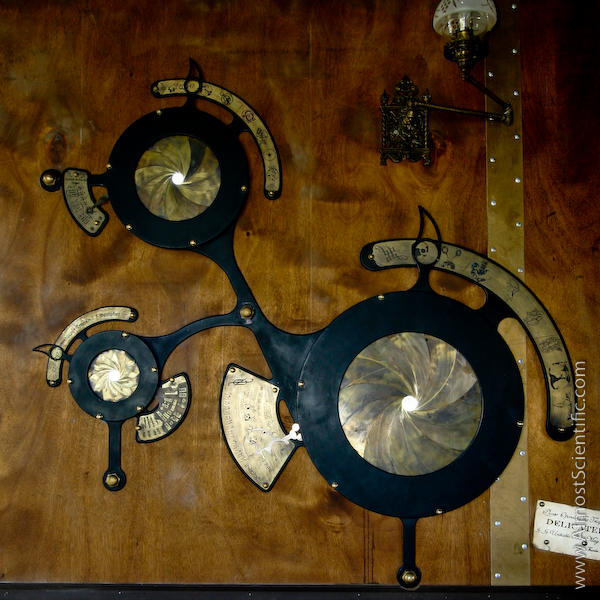
What was the first thing you built? (image- the Triaparator)
One of the fist things I really remember designing and building myself was a model-rocket engine gun when I was — geeze, 12? I don't recall if anyone got hurt — so I thin it was a success.
The first serious work of art I ever produced was the Triaparator, a series of three, fully functional, aperture windows for the Steampunk Treehouse.
|
|
What prompted your getting involved with Steampunk Treehouse? (image: one of the workstations in Alan's shop with remnants or beginnings of various projects)
Have you meet Sean Orlando (who is the project director) — he's rock-star hot. One look at him and I was in.
Ahhh, yeah, well. Really, it was the people that were involved. The project was based in NIMBY, the same industrial arts space where my shop is and it was a metal working project so I natural gravitated towards it. But very early on it stopped being about the project and became about working with the people that were assembled around it. They are nifty, creative, mega-fun folks who laughed when I thought I was saying something funny rather then look disappointedly at me and asked me to leave.
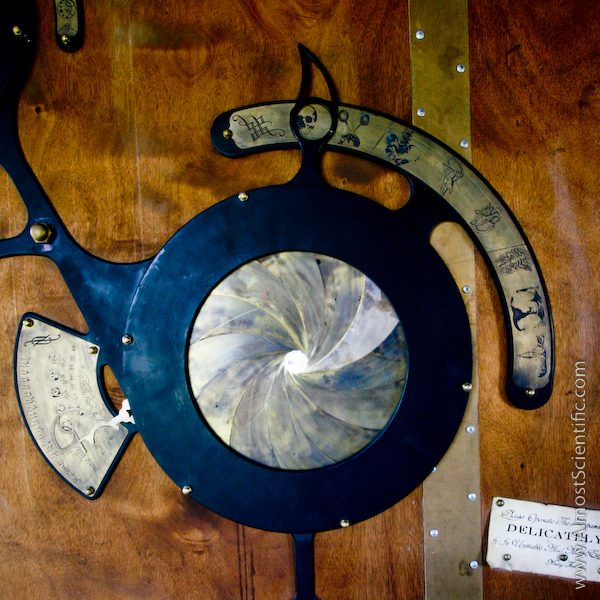
How did you go about designing and creating the Triaparator?
I bought the plans off eBay for $2.65 and paid a kid down the block $10 to fabricate it.
No, I had two apertures, one from a camera and another from a theater light, that I reverse engineered and then modeled on the computer. Originally I was just going to make one aperture window but once I had figured out how they worked and had built a CAD model it became easy to scale it to any size — so I made three. The real challenge was figuring out how to fabricate the pins that blades pivot on for three different size apertures.
My favorite thing about that piece is that an old friend (I hate you Lee) refers to them as sphincters. Which, is technically a good description of them given that the pupillary sphincter controls the iris of the eye, which is an aperture — but that's not why he calls them that.
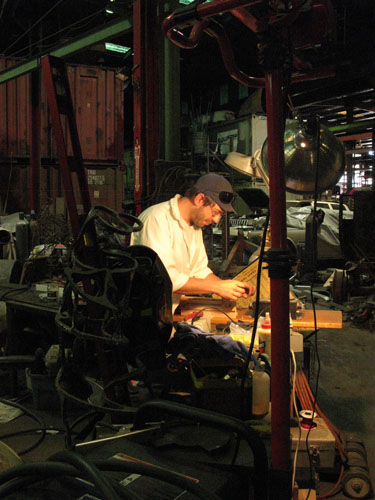
In the mad-frantic workspace like NIMBY, how the hell do you get anything done? (image: Alan in his shop at NIMBY)
Carefully and never cleanly.
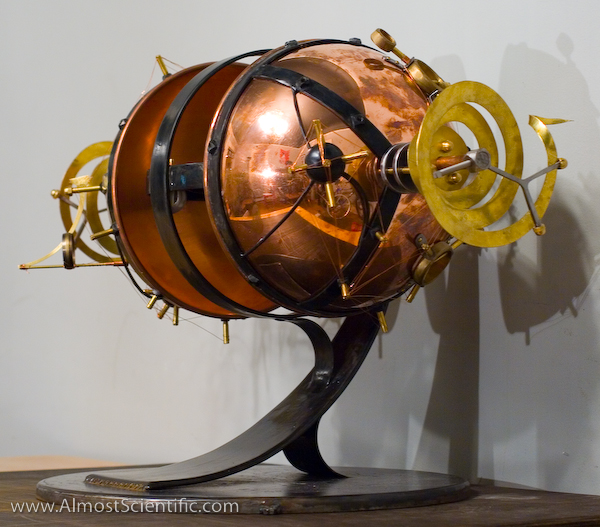
Do you criss-cross your arts and your sciences to make well-designed but "affront to humanity" type cyborg or evil android super weapons?
(image: the Dihemispheric Chronaether Agitator)
After I graduate collage I spent two years living down in DC doing research for the government — all that work is very hush-hush and I'm not permitted to discuss it at all.
But I built a series of cyborg, miniature schnauzers with the capacity to communicate by yodeling punk rock song; they could also launch gherkins from their anus at supersonic velocities as a defensive measure.
I also weaponized two of the English vowels.
Neither project got beyond the beta stage of field-testing and two of the schnauzers are AWOL somewhere in Switzerland. Schnauzers are vindictive and never forget — Sometimes I fear for my safety.
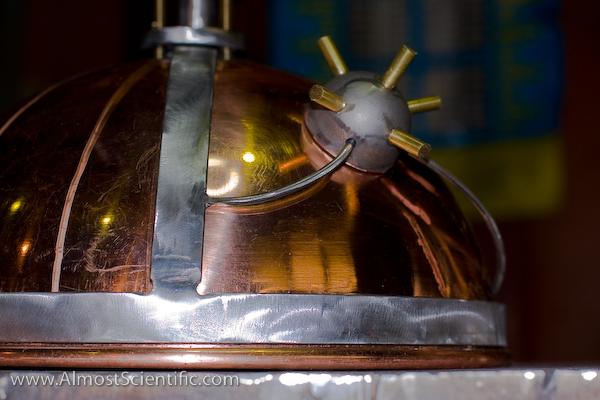
What do you have planned for the future? (image: detail of the Dihemispheric Chronaether Agitator)
If all goes according to plans (HA!) I should be starting a new project, The Neuron Chamber. You the reader can follow its fabrication over the next month over at my blog. And when that's done I'm going to finish my Ph.D. thesis.
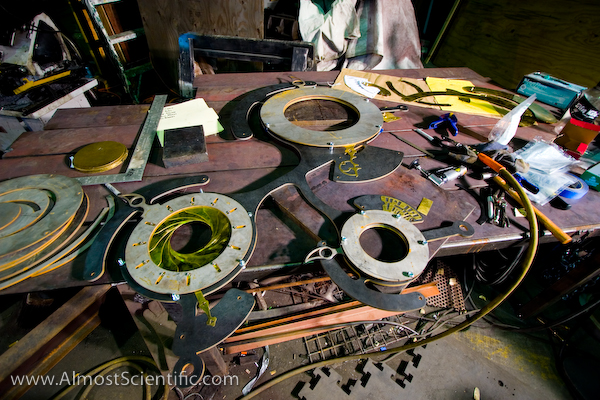
How is The Neuron Chamber related to your research? (image: The Triaparator being built)
The Neuron Chamber is an interactive, electric-kinetic sculpture of a neuron in an observation chamber. It's thematically related to my research in that I do study neurons but the ones I study are really super tiny and much softer.
I'm very interested in using my art to communicate complex scientific concepts to people.
Scientists spend allot of time interacting with the world when they study it and they develop a set of intuitions that guide their research and help them come to a deep abstract understanding of the world. Almost always, it's the final abstract understanding that is communicated to the non-scientific public. I want to create interactive, aesthetic environments that help build up the same intuitions that scientists develop. That way, when someone reads about some new scientific finding that have a physical experience that can support their understanding.
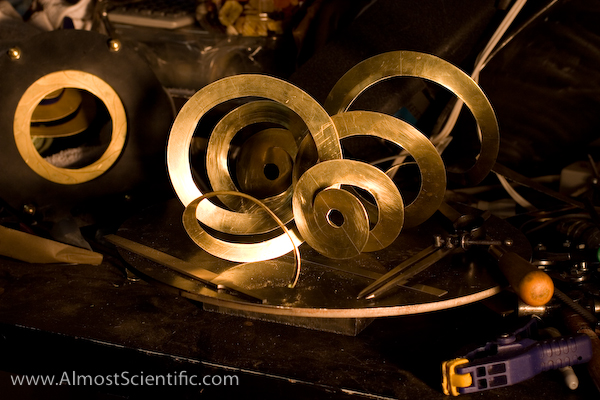
Advice for aspiring Doc Browns? (image: detail of parts of the DCA)
1- Always wear pants in the lab and shop — even if you think no one is coming over.
2- Own a dog and have regular chats with him/her — dogs know stuff about things.
3- Have a good set of files on hand — the first machinist was a dude with vice and file.
4- Stop talking about what could or might happen and do the experiment — you never really know.
5- Don't force it — use a bigger hammer.
